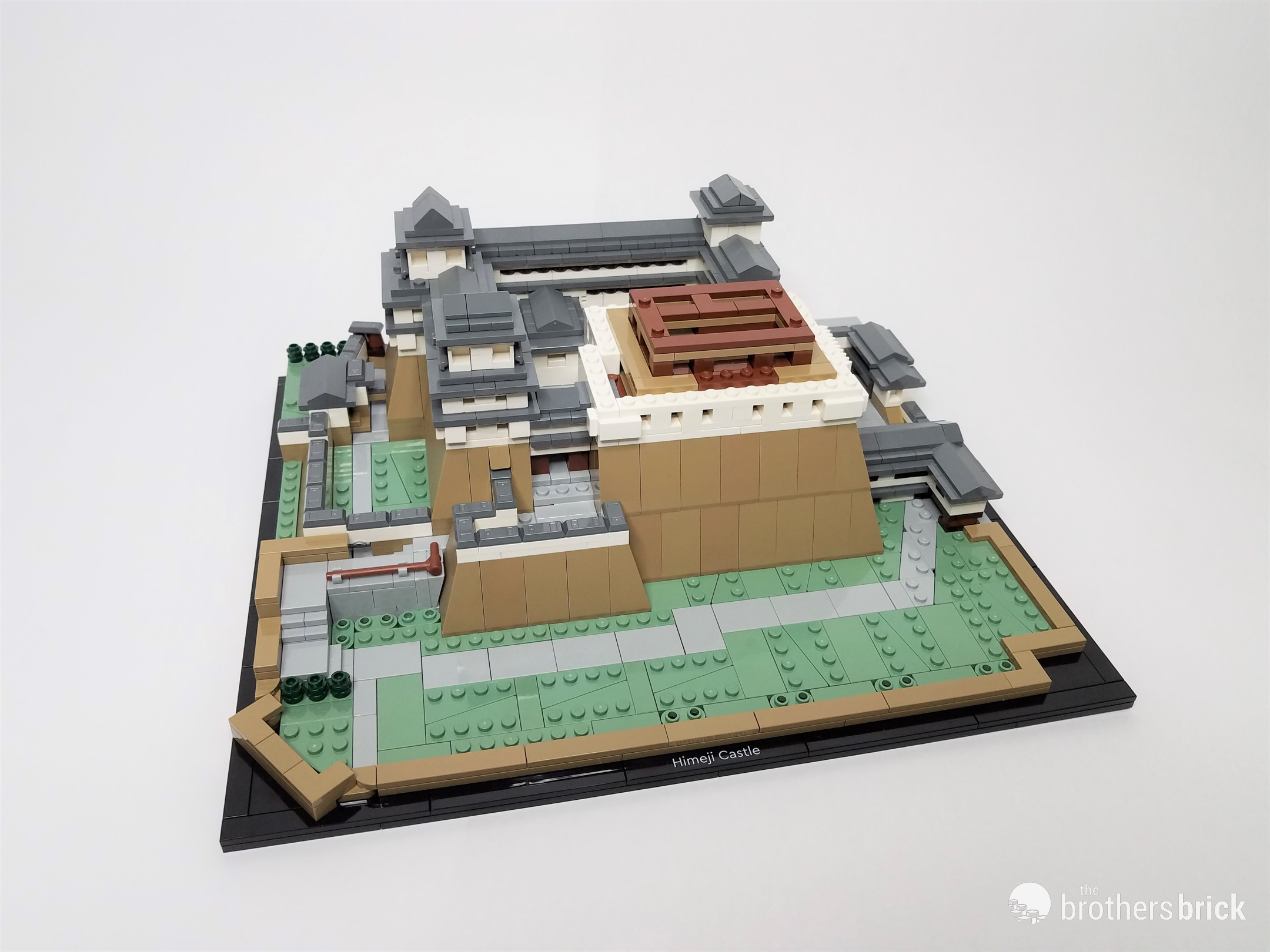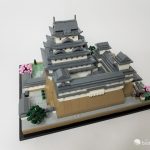In just a few days, LEGO will celebrate an astounding architectural wonder 30 years after it was christened a UNESCO World Heritage Site with the release of a new Architecture set. 21060 Himeji Castle is a breathtaking example of the feudal Japanese style, having stood the test of time since 1333. And while the castle has seen countless wars, upgrades, and natural disasters over its nearly 700-year lifespan, we’ll have to see how the Castle of the White Heron does with a real test: a Brothers Brick review. The set is made of 2,125 pieces and is available from LEGO stores and Shop-at-Home starting on August 1st for US $159.99 | CAN $209.99 | UK £139.99.

The LEGO Group sent The Brothers Brick an early copy of this set for review. Providing TBB with products for review guarantees neither coverage nor positive reviews.
Unboxing and instructions
The castle arrived in a large box sealed with tape. The front of the container features a beautiful shot of the set, along with the usual Architecture accouterments. I love the Himeji Castle “logo” in the upper right corner, with the name spelled out in English and Kanji along with the location of the site. The back shows the backside of the model, a “play feature,” some details, and a shot of the landmark itself.
As per usual for a large set, the instructions are sealed in a cardstock envelope to prevent folding and wrinkling. The front of the booklet has another image of the set, LEGO branding, and a QR code to download the LEGO Builder app in case that’s preferred over the paper. The back of the instructions sports a sketch rendering of the castle set. Within its pages, there’s a great section on the UNESCO World Heritage site giving a short history and discussing some of the brilliant architectural features of the structure.
Also included in the box are 18 bags: two marked with a 1, and the rest numbering 2-17. For the sake of the build, I’ve broken the bags up into sections. Both bags 1s cover the base, bags 2-5 lay out the grounds and the first level of fortification, bags 6-8 handle the small buildings on the interior and exterior of the main wall, bags 9-12 complete the walls and first level of the main keep, 13-16 finishes out the structure, and bag 17 completes the surrounding grounds with some trees.
The build
Both Bag 1s combine to make a very “LEGO Architecture” base. Ringed with black tile, this base already feels sturdy enough for the large build that’s coming. However, there’s not too much to report on at this point.

That is to say, except for the alternate nameplate. Spelling out “Himeji-jō” in Kanji, you can replace the English placard with its alternate. It’s a very fitting inclusion in the set, and one that I hope catches on for all Architecture sets, or at least the large ones.

The next round of bags (2-5) start adding some color to the build. The grounds are awash in sand green, crisscrossed with plenty of light gray pavement. Some small bits of foliage and wall structures are put in place, but nothing like what we’ll see in the following bags. The technique of half-stud stairs comes into play quite a bit here, adeptly achieved with jumper plates. And I also adore the stud management applied by designer Chris McVeigh. When reasonable, it adds some depth to the grounds and helps break up all the flats around the castle.

Heading into the third round of bags (6-8), the grounds are further developed with additional buildings. While LEGO wasn’t able to recreate all 83 buildings in the Himeji complex, there certainly are a lot of storehouses and gates assembled throughout the build. It’s also at this point that I began to take note of the repeating patterns in the build, like the peaked slopes atop a line of 1×3 jumper plates, or the rows of ingot tiles along the walls. This is very much an assembly of those patterns, repeated and reoriented over and over again. They may be adjusted to fit a specific nook or allow for a given feature to emerge, but those common patterns are always there. We’ll revisit that concept at the end.

Next, I crack open bags 9-12. This completes the main wall, its trio of towers, and starts the first floor of the main keep. New patterns have again emerged, this time windows of a half-stud width pepper the white walls of the set. And, as featured on the box, the interior “play feature” comes to life. In the end, this was a pretty modest attribute (see picture below of the final model) and didn’t feel like more than a stylized means of sectioning the castle’s central tower. That said, I don’t think there was much more that could reasonably be done in that space without significantly up-scaling the whole set. So definitely not a missed opportunity, but also not something that I think is worthy of the back of the box.

Nearing the end of the build, I launch into bags 13-16. These pieces complete the keep and nearly the whole build at that. Features like the boomerang eaves and the textured parts of the wall help to break up the creation, keeping it as true-to-life as any other Architecture set. The new corner piece on the roof fits in perfectly and is a worthy addition to the growing LEGO part library. I don’t know how else that upturn on the 45° could be handled in bricks, especially at this scale.

But before heading to that final bag, we’ve got to talk about the top of the roof. This assembly is absolutely brilliant, and my favorite part of the whole build. The shaping is perfection, calling on minifigure heads, triangle tiles, and candlesticks to pull off an iconic bit of feudal Japanese architecture. McVeigh, you’ve done it again!

Finally, bag 17 is popped, and I assemble some additional vegetation for the grounds. And this is probably my biggest critique of the set. For all the cherry blossoms featured in the pictures of Himeji Castle on the box and instructions, two dinky trees feel like a miss. I can understand that there’s a balance here, not wanting excess leaf-ery to disrupt the excellent view of medieval architecture. But a couple more trees wouldn’t have hurt anything, even if it meant losing the swapability of green-leafed trees with full-bloom.

The parts
Now for my favorite section in any review: all the awesome pieces I get to build with. This set doesn’t feature too much new or noteworthy, but it does offer the new upturned roof corner parts previously mentioned, as well as the dark gray boomerangs and the 2-long bars in reddish brown (see picture below). But what this set lacks in new, it definitely makes up for in bulk. Himeji Castle has 60 1×3 jumpers in dark gray, 98 1x1x2/3 bricks in white, 20 of those boomerangs, 16 2×3 tiles in light gray, and 41 2×4 dark gray jumper plates.

Conclusions and recommendations
As I said earlier, there are a lot of repeating patterns in this build. And typically, this would lead to a pretty humdrum assembly process (I’m looking at you, Dried Flower Centerpiece). But Himeji Castle manages to disguise those repeated patterns effectively throughout the build experience. At no point did I lament another round of layering jumpers on top of bricks. In fact, thanks to the creative nature of the connections employed by McVeigh (relying on atypical offset connections to generate that half-stud lip on the roof, for instance), I remained engaged and eager to pry open the next bag! Dare I say it, this might be my favorite of the LEGO Architecture sets from a build-process perspective. Yes, there are some minor changes I would’ve preferred, like the inclusion of more cherry blossoms. But overall, 21060 Himeji Castle gets a strong recommendation from me: fun and relaxing to build, with a final product that’s a wonderful display piece.
21060 Himeji Castle is made of 2,125 pieces, and will be available from LEGO stores and their website starting on August 1st. It will retail for US $159.99 | CAN $209.99 | UK £139.99.
The LEGO Group sent The Brothers Brick an early copy of this set for review. Providing TBB with products for review guarantees neither coverage nor positive reviews.
Here’s a gallery with all the review images:































